牛津初中英语教学案例精选一
- 格式:doc
- 大小:55.37 KB
- 文档页数:9

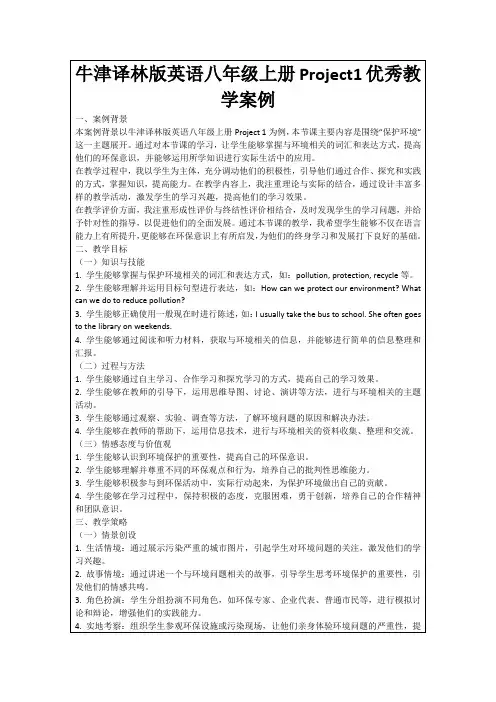
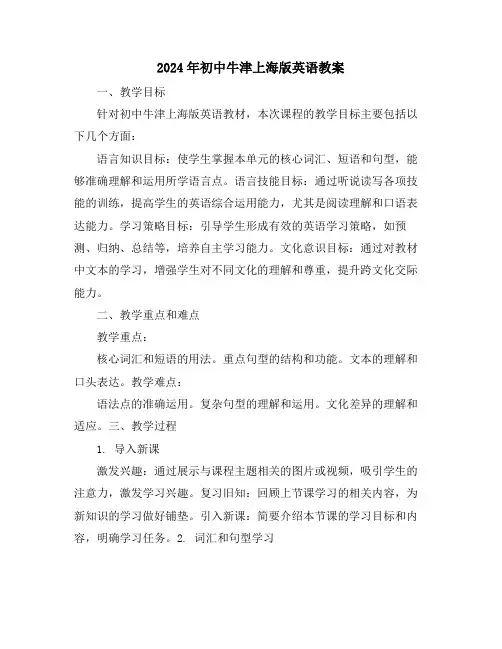
2024年初中牛津上海版英语教案一、教学目标针对初中牛津上海版英语教材,本次课程的教学目标主要包括以下几个方面:语言知识目标:使学生掌握本单元的核心词汇、短语和句型,能够准确理解和运用所学语言点。
语言技能目标:通过听说读写各项技能的训练,提高学生的英语综合运用能力,尤其是阅读理解和口语表达能力。
学习策略目标:引导学生形成有效的英语学习策略,如预测、归纳、总结等,培养自主学习能力。
文化意识目标:通过对教材中文本的学习,增强学生对不同文化的理解和尊重,提升跨文化交际能力。
二、教学重点和难点教学重点:核心词汇和短语的用法。
重点句型的结构和功能。
文本的理解和口头表达。
教学难点:语法点的准确运用。
复杂句型的理解和运用。
文化差异的理解和适应。
三、教学过程1. 导入新课激发兴趣:通过展示与课程主题相关的图片或视频,吸引学生的注意力,激发学习兴趣。
复习旧知:回顾上节课学习的相关内容,为新知识的学习做好铺垫。
引入新课:简要介绍本节课的学习目标和内容,明确学习任务。
2. 词汇和句型学习呈现新词汇:通过实物、图片或多媒体等方式呈现新词汇,帮助学生直观理解。
讲解词汇用法:详细解释新词汇的用法,包括词性、搭配等,并给出例句。
句型操练:通过替换、填空等方式,让学生操练重点句型,加深对句型的理解。
3. 文本理解和口头表达阅读文本:指导学生阅读教材文本,注意理解文本中的重点信息和语言点。
小组讨论:组织学生进行小组讨论,就文本内容展开讨论,培养口语表达能力。
汇报交流:每个小组选派代表汇报讨论成果,其他同学进行点评和补充。
4. 语法点讲解和练习呈现语法点:明确本节课的语法点,通过例句展示其用法。
讲解语法规则:详细解释语法点的构成和用法,帮助学生理解。
语法练习:设计多种形式的练习,如填空、选择、改写等,让学生充分练习。
5. 文化差异理解和适应对比文化:通过对比中英文化中的相似点和差异点,帮助学生理解文化差异。
讨论交流:组织学生就文化差异进行讨论交流,分享自己的见解和体验。
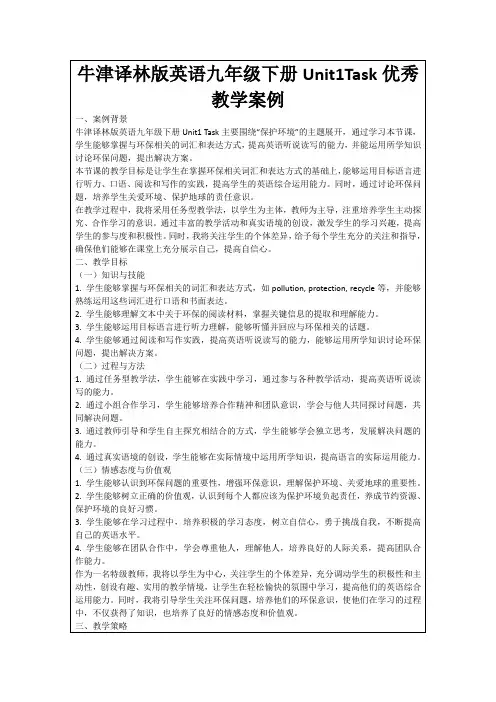
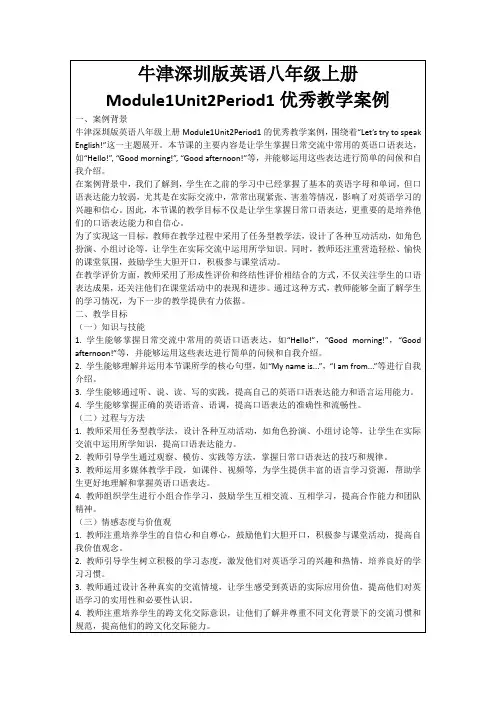
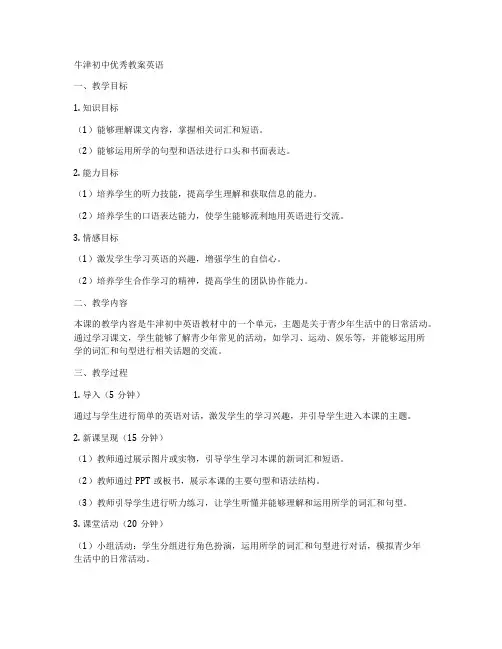
牛津初中优秀教案英语一、教学目标1. 知识目标(1)能够理解课文内容,掌握相关词汇和短语。
(2)能够运用所学的句型和语法进行口头和书面表达。
2. 能力目标(1)培养学生的听力技能,提高学生理解和获取信息的能力。
(2)培养学生的口语表达能力,使学生能够流利地用英语进行交流。
3. 情感目标(1)激发学生学习英语的兴趣,增强学生的自信心。
(2)培养学生合作学习的精神,提高学生的团队协作能力。
二、教学内容本课的教学内容是牛津初中英语教材中的一个单元,主题是关于青少年生活中的日常活动。
通过学习课文,学生能够了解青少年常见的活动,如学习、运动、娱乐等,并能够运用所学的词汇和句型进行相关话题的交流。
三、教学过程1. 导入(5分钟)通过与学生进行简单的英语对话,激发学生的学习兴趣,并引导学生进入本课的主题。
2. 新课呈现(15分钟)(1)教师通过展示图片或实物,引导学生学习本课的新词汇和短语。
(2)教师通过PPT或板书,展示本课的主要句型和语法结构。
(3)教师引导学生进行听力练习,让学生听懂并能够理解和运用所学的词汇和句型。
3. 课堂活动(20分钟)(1)小组活动:学生分组进行角色扮演,运用所学的词汇和句型进行对话,模拟青少年生活中的日常活动。
(2)个人活动:学生根据所给的题目,用所学的词汇和句型写一段短文,描述自己的日常活动。
4. 巩固练习(10分钟)教师通过发放练习册或提供练习题,让学生进行书面练习,巩固所学的词汇和句型。
5. 总结与作业布置(5分钟)教师对本课的主要内容进行总结,布置相关的作业,让学生回家后复习和巩固所学知识。
四、教学评价1. 课堂参与度:观察学生在课堂上的积极参与程度,如发言、回答问题、互动等。
2. 作业完成情况:检查学生完成作业的质量,如拼写、语法、表达等。
3. 口语表达能力:评估学生在角色扮演和口头表达中的流利程度和准确性。
通过以上评价,教师能够了解学生的学习情况,及时调整教学方法和策略,提高教学质量。
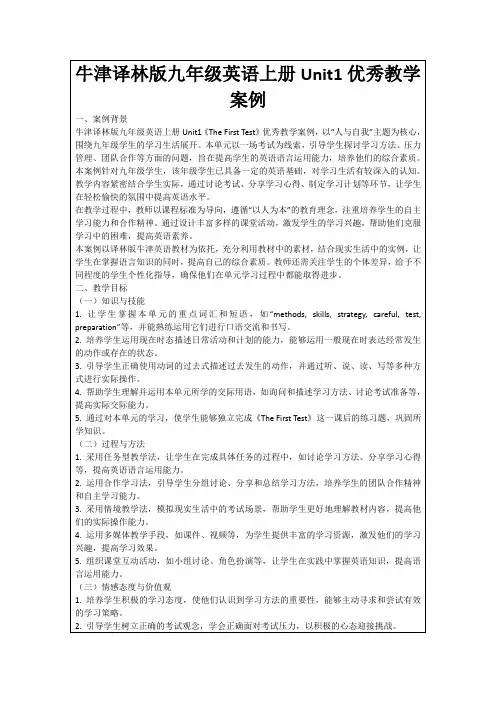
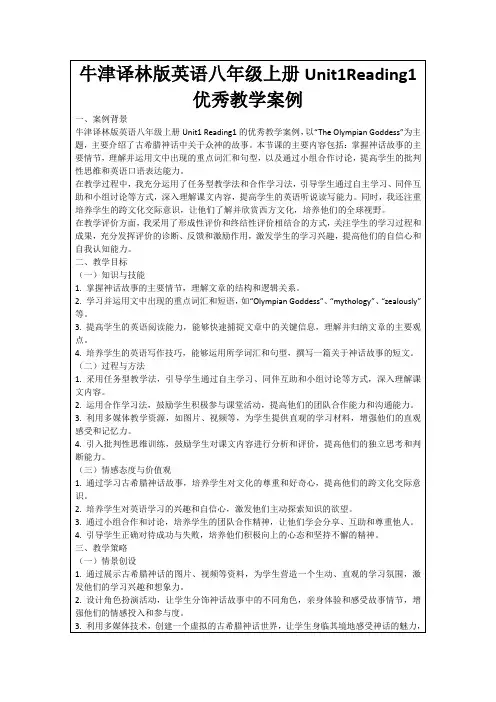
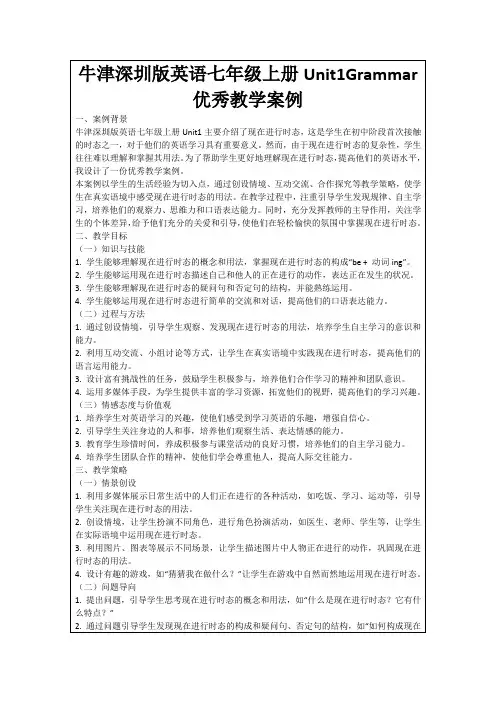

-《牛津初中英语》教教事例一年级:初一学科:英语学校:南京市第十二中学执教:潘洁Unit 4Comic strip & welcome to the unitTeaching aims:1. Introducing names of interesting facts and strange things.2.Discussing something unusual and express the feeling. Teaching aids: MultimediaTeaching methods: 1. Asking and answering.2.Listening and reading.3.Free talk4.Imagination.Teaching procedures:Step 1 Lead-in1.Show some pictures and ask: How do you feel when you see these pictures?Look at the man, he has a long mustache. Isn't heamazing?If you meet a man like this on a bus. How do you feel?Strange And this pig, look carefully,What’ s it made of? It’ s made of orange peel.Isn’ t wonderful?it What is he doing? He is playing a yo-yo. I think he is very clever. Isngreat? This dog is lazy, it is sleeping, and it is dreaming of eating. Isnfunny?And these babies are in the pumpkins. Aren interes’ting?they Lovely?2 . R ead these words. (interesting, funny, wonderful, amazing, great, strange, lovely)策略:精心选择六幅图片,包括生活中、自然界一些稀罕异异的人,动物或’ tit’ tit现象。
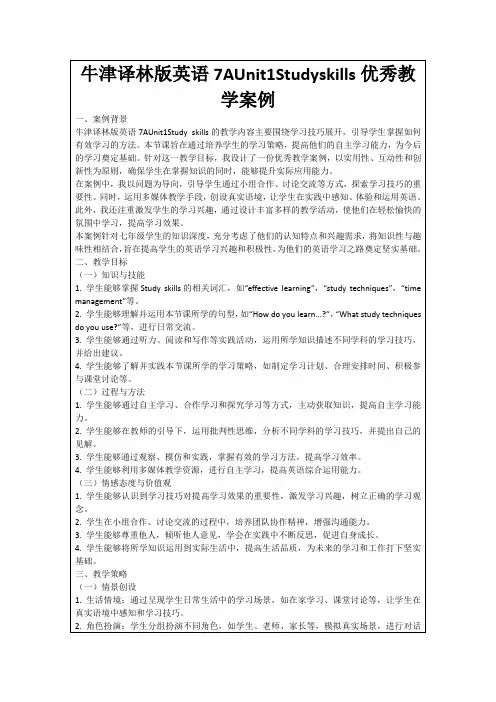
最新牛津版英语初中七年级上册全册精品
教案
第一单元:打招呼与自我介绍
教学目标:
- 学会用简单的英语打招呼和自我介绍
- 掌握一些常见的问候语和回答方式
- 能够用英语介绍自己的年龄、姓名、国籍和爱好
教学准备:
- 学生课本和练册
- 教学投影仪
- 音频设备
教学步骤:
1. 引入:播放英语打招呼的视频,让学生感受英语在生活中的应用。
2. 激发学生兴趣:用图片和肢体语言示范常见的问候动作,如握手、拥抱等,并鼓励学生模仿。
3. 研究常见问候语:通过图片和示范,教授英语中常见的问候语,如"Hello","Good morning"等,并让学生跟读。
4. 听力训练:播放相关音频,让学生听力理解和模仿说出各种问候语。
5. 练对话:分成小组进行对话练,让学生用英语进行简单的问候和回答。
6. 自我介绍:示范用英语进行自我介绍,并解释一些常用的句型和词汇。
7. 小组活动:让学生在小组内互相介绍自己的姓名、年龄、国籍和爱好,并鼓励用完整的句子进行表达。
8. 温故知新:通过游戏或练册的相关练,巩固所学内容。
9. 总结:引导学生总结本课所学内容,并鼓励他们在日常生活中多用英语进行问候和介绍。
教学评估:
- 观察学生在对话和小组活动中的表现,评估他们是否能够正确运用所学内容。
- 检查练册上的完成情况,了解学生的掌握程度。
扩展活动:
- 邀请外教或英语达人来校与学生进行互动交流,进一步提高他们的英语口语能力。
- 给学生布置任务,让他们到校园或社区中用英语与陌生人进行简单的交流。
《牛津初中英语》教学案例一年级:初一学科:英语学校:南京市第十二中学执教:潘洁Unit 4 Comic strip & welcome to the unitTeaching aims:1. Introducing names of interesting facts and strange things.2. Discussing something unusual and express the feeling. Teaching aids: MultimediaTeaching methods: 1. Asking and answering.2.Listening and reading.3.Free talk4.Imagination.Teaching procedures:Step 1 Lead-in1.Show some pictures and ask: How do you feel when you see these pictures?Look at the man, he has a long mustache. Isn't heamazing?If you meet a man like this on a bus. How do you feel?Strange And this pig, look carefully,What’ s it made of? It’ s made of orange peel.Isn ’ t wonderful?itWhat is he doing? He is playing a yo-yo. I think he is very clever. Isn great? This dog is lazy, it is sleeping, and it is dreaming of eating. Isn funny? And these babies are in the pumpkins. Aren interes’ting?they Lovely? ’ tit ’ tit2.Read these words. (interesting, funny, wonderful, amazing, great, strange,lovely)策略:精心选择六幅图片,包含生活中、自然界一些稀奇古怪的人,动物或现象。
在提问过程中,有意识地用amazing, strange, wonderful, great, funny,interesting, lovely 回答问题,使学生对本课的重点词汇有一个初步的了解。
通过展示六幅图片,引起学生兴趣,帮助学生初步感知本课的主题,amazing things.Step 2 PresentationShow the pictures about lighting, rocket, sneezing, elephant, goldfish,tortoise, giraffe and the tallest man, talk about each picture .1. Who is he? Yao Ming. How tall is he?Do you know the tallest man in the world? He was from the USA, hewas about 2.72 m tall. He died in 1940. What a pity!-策略:通过姚明,吸引学生注意力,进一步引申出世界上最高的人。
2.What’ s this? It’ s a rocket.I hope I could travel to the moon by rocket one day. I think it is great. 策略:强调现在只要三天时间就可以到月球。
3.What can you see? Lighting. And some plants.(plant life)We know people can ’ t live withoutwater, but do you know plants can ’ t livewithout lightning? Here is the answer.4.What’ s the woman doing? Yes, she is sneezing.Look at her eyes , Is her eyes closed or open? Closed.How do you sneeze?When we sneeze, we often keep our eyes closed.Have a try. Isn ’ t it strange?策略:请学生上台演示,怎样打喷嚏,注意观察眼睛。
将教材内容生活化,激发学习兴趣,增强学习效果。
5. It ’ s an elephant. Can you say something about elephants?(They are grey, they sleep on their feet, they are strong, they have longnoses and big ears.)How do they walk? They walk on tiptoe.6. This is a goldfish. Say something about goldfish?(Where do they live? Can they swim? How can they sleep? With their eyesopen or closed? And they have poor memory. They can only rememberthings for three seconds.策略:此处的任务设计呈现阶梯性的原则,由简到难。
现告诉学生金鱼睁着眼睛睡觉,再告诉学生金鱼的记性很差,只能记住三秒前的事情。
7.Watch a film. It ’ s about a tortoise. What do you know about tortoises?Have you seen one? Where do they live?It can live many years. It has long life. Some can live up to 150 years old. It looks small, but it can live so long. Isn ’ t it funny?8.Look at the giraffe. It is the tallest animal in the world. It has a long neck How many bones are there in its long neck? Only seven. It ’ s amazing.策略:这是本节课的核心内容。
进一步利用图片信息理解主题,先逐个讨论课文 A 部分的六幅图片,尽量调动一些有学习偏差,但有积极性的同学说英语,给他们表现自我的机会。
再讨论Integrated skill A2 部分的 tortoise ,giraffe。
配合一小段视频,活跃课堂气氛,提高学生积极性。
Step 3 Practice1.Divided the students into groups and discuss the pictures.2.Ask some students to describe the pictures.策略:集中展示以上几幅图,让学生任选一副,自由讨论。
通过这一环节巩固知识点,增强学生的记忆效率,以达到最终的教学目的。
Step 4 Practice1.Match the pictures with the sentences.策略:通过以上两个环节,学生对图和一些相应的句子己经有了较深的印象,此时做 match 练习,水到渠成。
学生主动地获取了新知识。
2. Present the dialogue below:—Do you know that fish sleep with their eyes open?—Oh, really?—Isn ’t thatinteresting ?—Yes, it is. Do you know?3.Work in pairs and try to make a similar one.4. Check some pairs.策略:乘热打铁,呈现 B 部分的句型,再次复习六个形容词,强化记忆。
通过小组活动培养学生较强的交流意识和互助行为。
Step 5 Comic stripMeet Eddie and Hobe. Talk about what they are doing.Listen to the tape, and answer: What do they see? A plane or a UFO?1.UFO means Unidentified Flying Objects.2.Read the comic strip策略:通过听录音,让学生猜两只狗看到的到底是飞机还是飞碟。
Step 6 Free talkThe world is full of amazing things. Say something about them.策略:此处的任务设计就是要学生解决问题,获得新知。
通过这一环节,给学生创造思考的机会,帮助学生认知并发展潜能,激发学生的内在动机。
Step 7 Exercises1 Use the following words to fill in the blanks.travel, rocket, tiptoe, without, plant, sneeze, the USA, open, live up to1)It takes about three days to ____ from Earth to the moon by _____ .2) A tortoise can ______ 150 years old.3) A man in _____ was 2.72 metres tall.4)Fish can sleep without their eyes _____.5)Elephants walk on ____.6)You cannot _____ and keep your eyes open at the same time.7)There is no _____ life _____ lighting.2 Translate the following sentences into English.1)我奶奶能活到 90 岁。